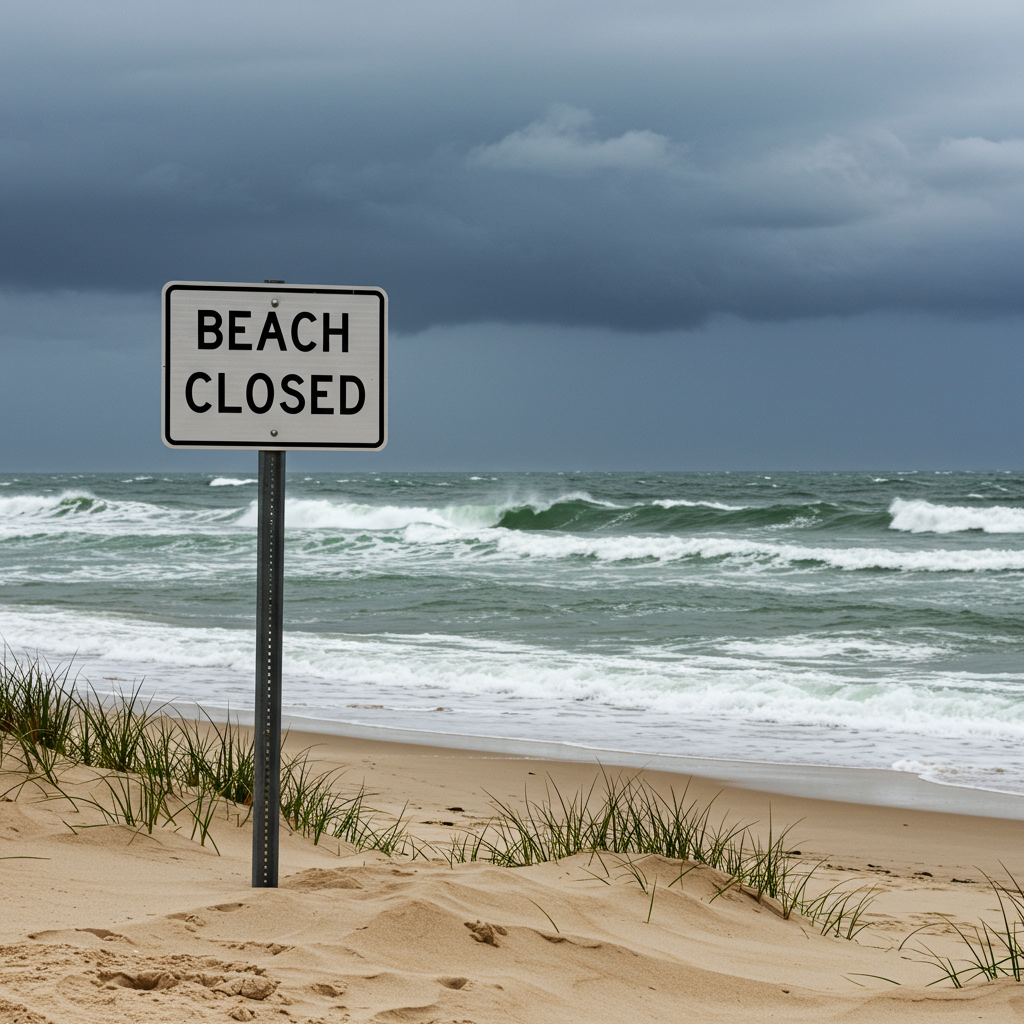As Hurricane Erin churns offshore, its powerful reach extends far beyond its eye, unleashing a cascade of dangerous conditions across the U.S. East Coast. This isn’t a direct hit for most, but a significant safety alert for anyone near coastal waters. From mandatory evacuations in North Carolina to widespread swimming bans along the Jersey Shore, officials are urging extreme caution. Understanding these evolving threats, particularly life-threatening rip currents and colossal waves, is crucial for staying safe.
Hurricane Erin’s Widespread Coastal Threat
Despite Hurricane Erin’s projected path keeping it largely offshore, its immense size and powerful winds are stirring up a hazardous reality for East Coast beaches. This robust hurricane, which has fluctuated in strength from Category 2 to 4, acts like a giant blender, generating immense swells that travel hundreds of miles from its center. The National Weather Service and local authorities are issuing urgent warnings, emphasizing that even without a direct landfall, Erin’s indirect impacts pose severe risks to swimmers and beachgoers alike. The primary concerns include dangerously high surf, significant coastal flooding, and insidious rip currents capable of pulling even strong swimmers out to sea.
North Carolina’s Outer Banks Under Mandatory Evacuation
The immediate and most severe impacts are centered on North Carolina’s iconic Outer Banks. Dare County officials declared a state of emergency on August 17th, initiating a mandatory evacuation for Hatteras Island effective 6 p.m. ET. This popular summer destination faces expected storm surge and waves exceeding 10 feet. Officials warn that the system, though offshore, will bring “life-threatening impacts” to the coastline. Coastal flooding and ocean overwash are anticipated to begin around August 19th and continue through August 21st. This could render portions of North Carolina Highway 12 on Hatteras Island “impassable” for several days.
Cape Hatteras National Seashore proactively closed beach accesses and facilities on August 18th. They issued clear guidance for visitors to “stay off the beaches completely and discontinue use of all beach trails and boardwalks” starting August 19th. Neighboring Hyde County followed suit, enacting a mandatory evacuation order for Ocracoke Island, effective August 19th. These pre-emptive measures underscore the gravity of the marine hazards expected for the region.
New Jersey & Delaware: Urgent Swimming Bans
Further north, the Jersey Shore and Delaware beaches are also experiencing significant disruptions. Despite Erin being over a thousand miles away, its distant influence is profoundly felt. On August 19th, beaches in Delaware and along the Jersey Shore implemented swimming bans. Popular spots like Wildwood, Margate, and Bay Head were affected. At Island Head Beach State Park in Berkeley Township, New Jersey, a comprehensive suspension of activities went into effect. This included swimming, surfing, boogie boarding, mobile sport fishing vehicle permit access, and nature center programs, all suspended through at least August 21st.
New Jersey Governor Phil Murphy explicitly urged both visitors and residents to avoid wading or swimming in the ocean. The rough surf along the New Jersey coast isn’t solely from Erin’s swells; it’s also compounded by strong easterly and northeasterly winds. This combination significantly heightens the risk of hazardous rip currents. Beach safety directors, like Joe Bongiovanni from Asbury Park, anticipate “very large waves, rough seas and dangerous rip currents” for most of the week. While some areas might allow ankle-deep wading, full swimming bans are widespread. Forecasts indicate breaking waves along the New Jersey coast could reach 8 or 9 feet, or even higher, with offshore waves potentially soaring to 15 to 20 feet.
Southern Coasts: Rip Current Dangers Extend South
The peril isn’t confined to the mid-Atlantic. Authorities in North Carolina reported approximately 60 people rescued from rip currents at Wrightsville Beach, leading to a no-swim order for the rest of the week. South Carolina also saw an individual rescued from a rip current. Furthermore, a dozen rip currents were reported across South Carolina and Georgia beaches on August 18th by the National Weather Service in Charleston. This widespread impact highlights that the danger is not isolated to specific states but rather affects much of the East Coast under Erin’s influence.
Understanding the Peril: Life-Threatening Rip Currents
Rip currents are a silent, deadly force in coastal waters. They are fast-moving channels of water that flow directly away from the shore, perpendicular to the coastline. Unlike undertows, which pull you down, rip currents pull you out to sea. Their danger lies in their deceptive speed and their ability to catch swimmers off guard. When caught, the natural reaction is to panic and swim directly against the current towards shore. This exertion quickly leads to fatigue, making it impossible to escape.
According to the National Oceanic and Atmospheric Administration (NOAA), rip currents are a leading cause of drownings. Since 2010, over 800 people have died in rip current drownings in the United States. As of late July, nearly half of all surf zone danger deaths this year were attributed to these powerful currents. Even experienced swimmers can be overcome by their strength if they don’t know how to react.
Essential Beach Safety: Navigating Dangerous Waters
Given the heightened risks from Hurricane Erin, adhering to beach safety guidelines is more critical than ever. Your safety and the safety of those you care about depend on vigilance and informed decisions.
Before You Enter the Water
Always check for any warnings or advisories before heading to the beach. Monitor local weather and water conditions constantly. Look for red flags, which signify dangerous conditions and swimming bans. The safest practice is always to swim near a lifeguard. Their presence means trained professionals are watching out for your safety and are equipped to respond to emergencies. If there’s no lifeguard on duty, it’s best to stay out of the water entirely, especially during periods of elevated risk like those brought by Hurricane Erin.
If Caught in a Rip Current
The most crucial advice if you find yourself caught in a rip current is to remain calm. Panic depletes energy and impairs judgment. Remember, a rip current will pull you away from shore, but it will not pull you under the water. Do not try to swim directly against the current; this will only exhaust you. Instead, swim parallel to the shore. Rip currents are typically narrow, so by swimming sideways, you can often escape their pull relatively quickly. Once you are free of the current, then angle your swim back to shore.
Helping Someone in a Rip Current
If you see someone struggling in a rip current, your immediate action should be to get help from a lifeguard. Alert them quickly and precisely. If no lifeguard is present, call 911 immediately. While waiting for emergency services, you can throw something that floats to the person, such as a life preserver, a cooler, or even a buoyant piece of driftwood. Crucially, do not enter the water yourself to attempt a rescue. Experts warn that people who try to help often become victims themselves, increasing the number of people in distress.
Beyond the Cone: Comprehensive Hurricane Preparedness
While Hurricane Erin’s track is positioned offshore, it’s a potent reminder that hurricane impacts extend far beyond the “cone of uncertainty.” That cone shows the probable path of the storm’s center, but dangerous conditions can spread for hundreds of miles. Track forecasts can also be off by an average of 60 to 70 miles, emphasizing the need for broad vigilance. This is especially true during the busiest period of hurricane season.
For residents and visitors along the East Coast, the indirect threats from Erin highlight the importance of general hurricane preparedness. This includes updating and checking your hurricane supplies, reviewing your home insurance policy, ensuring your home is storm-ready, identifying your evacuation zones, and determining if your area is prone to flooding. Continuous monitoring of official weather updates from the National Weather Service and local authorities remains paramount.
Frequently Asked Questions
What are the primary dangers associated with Hurricane Erin on East Coast beaches, even if it doesn’t make direct landfall?
Even without making a direct landfall, Hurricane Erin poses significant dangers to East Coast beaches primarily through life-threatening surf and rip currents. The storm’s large size generates immense ocean swells that travel hundreds of miles, creating exceptionally high waves and strong, narrow channels of water pulling away from the shore. Additionally, coastal flooding and ocean overwash are anticipated in certain regions, potentially making roads impassable and exacerbating hazardous conditions.
Which specific East Coast regions and beaches have issued warnings or closures due to Hurricane Erin’s impact?
Specific regions and beaches impacted by Hurricane Erin include North Carolina’s Outer Banks, with mandatory evacuations for Hatteras Island and Ocracoke Island, and closures at Cape Hatteras National Seashore. Along the New Jersey Shore, beaches in Wildwood, Margate, Bay Head, and Island Head Beach State Park (Berkeley Township) have implemented swimming bans. Delaware beaches also have closures. Furthermore, rip current warnings and rescues have been reported along South Carolina and Georgia beaches, extending the area of concern.
What critical safety steps should beachgoers take if they encounter dangerous conditions or rip currents during hurricane season?
If faced with dangerous beach conditions, always check official warnings and swim only where lifeguards are present. If caught in a rip current, the critical steps are to remain calm and avoid swimming against the current. Instead, swim parallel to the shore until you are free of the current, then angle back to land. If you witness someone else in a rip current, do not enter the water to help; immediately alert a lifeguard, call 911, or throw a floating object to the person.
Stay Safe, Stay Informed
Hurricane Erin serves as a powerful reminder of the ocean’s unpredictable nature, especially during hurricane season. While its direct path avoids most of the U.S. East Coast, its indirect impacts—dangerous surf, coastal flooding, and insidious rip currents—are very real and life-threatening. Prioritizing safety through vigilance, adherence to official warnings, and understanding rip current escape techniques is essential. Always respect the power of the ocean, stay informed by monitoring local weather advisories, and choose safety over recreation when conditions are hazardous.




